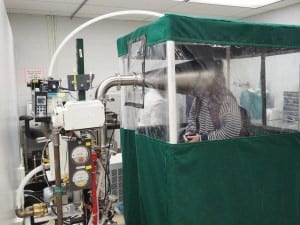By Mariam Awad
The main topics of the winter 2018 Mid-Atlantic Microbiome Meetup (M3) were pathogen detection, antibiotic resistance, and biodefense with emphasis on bioinformatics and bioimaging. The goal of the conference is to bridge the gap between academia, government and industry.
The keynote speaker, Dr. Tara O’Toole (Executive Vice President, In-Q-Tel & Director B.next) discussed how biology is going to fuel the global economy with biorevolution being the motto for this century. The talks that followed introduced various metagenomics analysis and visualization tools such as MEGAN, COSMOSID, MASH, KRONA, PAVIAN and Qiime1, 2- to name a few.
The M3 invited seminar speaker, Dr. Don Milton, discussed the “Got the Flu?” study which traces modes of transmission of various respiratory infections including influenza. It is surprising to hear that the transmission of influenza is a controversial topic among the scientific community. Wash your hands; cover your mouth when you sneeze/cough- are flu etiquettes; which researchers have recently questioned their effectiveness as deterrents against respiratory infections. “Do kids in school get the flu because they are not washing their hands, or is there not enough air circulating in the classroom?”
Understanding modes of transmission of influenza is an important task for both public health and biodefense experts. In the event that there is a novice influenza epidemic (natural or deliberate) in the United States, knowing how to stop person-person transmission is essential especially as the vaccine-production process may delay.
“Got the Flu?” subjects are University of Maryland College Park undergraduate students. “Any first-year student in the Global Public Health, Life Sciences or Science, Technology and Society College Park Scholars living-learning communities can enroll in the study any time they get a cold or flu”. Once they report with sickness, nose and throat swabs are taken and samples of their exhaled breath are gathered using a special machine called the Gesundheit II.

This tool captures the virus aerosols from breath, coughs and sneezes and can determine whether there’s more virus shed in large droplet sprays or in the tiny airborne particles. Along with tracking the ventilation system in the designated dormitory buildings, researchers give participants a tracker (via a smartphone app) that can keep record of their locations to understand pattern of virus transmission as they interact with their peers and staff around campus. Besides tracking their location, smartphones are examined for germs found on their surfaces.
While the study is still underway, if it can show that respiratory viruses such as influenza exhibit higher probability of airborne transmission compared to direct/indirect contact, then the implications on future public health and biodefense countermeasures would be tremendous. Hospitals would need to think differently about the ventilation system for patient rooms. Furthermore, the air travel industry would need to look into how to reduce transmission of airborne respiratory viruses in the already still-air environment of an aircraft. In addition to disinfecting surfaces, schools, malls and other populated facilities would need to figure out how to purify and better circulate the air to reduce viral airborne particles.
Some interesting take-away points from the study thus far are the lack of correlation between infection in lung and nose. In other words, the viral particles found in the lungs of sick subjects were different from those in the nose of the same individual. This was also the same conclusion when a similar study was conducted on ferrets. Second, students who had multiple influenza vaccinations, shed more virus when they got sick than those with fewer vaccine inoculations.
An interesting question raised at the end of the talk is how one’s microbiome composition can influence their susceptibility to respiratory viruses including that of influenza.
For more in-depth coverage on these talks, please see:
- UM Researchers Study How Flu is Spread
- Researchers Investigate How Flu and Colds Spread, and How to Predict Them
- UMD Scientists Are Trying to Figure Out Why Dorms Are So Contagious
- UMD Flu Study Tracks Infection as Influenza Peaks in Maryland
- As Ebola Spreads, So Have Several Fallacies
- Donald Milton – Professor of Environmental Health, Applied Environmental Health


